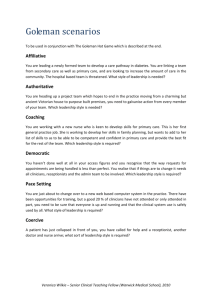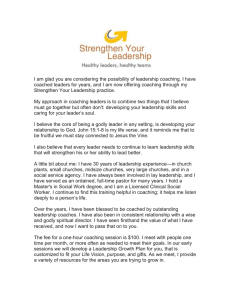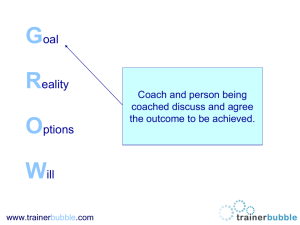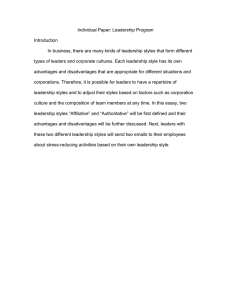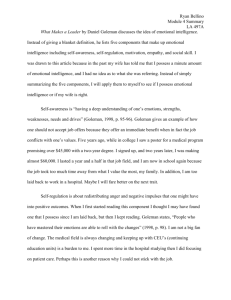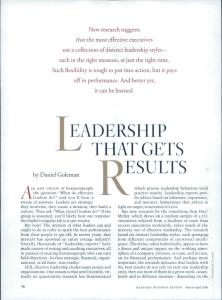Practical Leadership – 15.974
advertisement
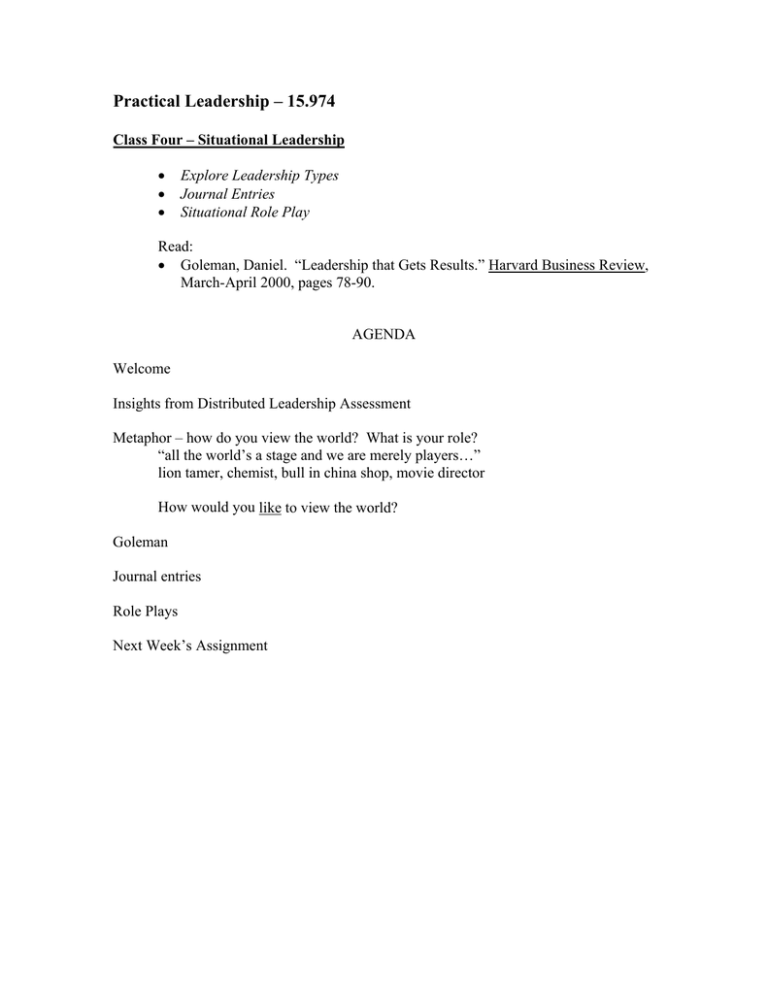
Practical Leadership – 15.974 Class Four – Situational Leadership • • • Explore Leadership Types Journal Entries Situational Role Play Read: • Goleman, Daniel. “Leadership that Gets Results.” Harvard Business Review, March-April 2000, pages 78-90. AGENDA Welcome Insights from Distributed Leadership Assessment Metaphor – how do you view the world? What is your role? “all the world’s a stage and we are merely players…” lion tamer, chemist, bull in china shop, movie director How would you like to view the world? Goleman Journal entries Role Plays Next Week’s Assignment Goleman, Daniel. “Leadership that Gets Results.” Harvard Business Review, MarchApril 2000, pages 78-90. Goleman has six styles: (LOOK AT TABLE) Coercive – demands immediate compliance Authoritative – mobilizes people to a vision Affiliative – creates harmony and builds emotional bonds Democratic – forges consensus through participation Pacesetting – sets high standards for performance Coaching – develops people for the future These work best in different situations Coercive – in a crisis, kick start a turnaround, problem employees. Are you ready to lead in an emergency (WTC, Anthrax, harassing law suits) Authoritative – when changes require new vision, when clear direction is needed – THIS SHOULD BE YOUR DEFAULT MODE. Affiliative – to heal rifts in a team, motivate others during stressful times Democratic – build buy-in or consensus, get input from valuable employee Pacesetting – get quick results from highly motivated and competent team – Coaching – help employee improve or develop long-term strengths. Succession planning. “Bus test.” LIMITATIONS Coercive – only good for short emergency (but is necessary then) – otherwise too damaging to morale and team work. May alienate the staff. “Holding their feet to the fire” is not effective over the longer term. Authoritative – too pompous/out of touch if all are experts. May seem overbearing depending on situation – especially if undermines egalitarian team Affiliative -- may result in the staff working under their capacity, not having a sense of urgency. The internal focus on working well together does not always translate into a focus drive to respond to the customer. Democratic – takes too long in emergency. Can take “too long” if criteria for success has a specific time frame. Doesn’t work if staff not qualified to offer sound advice. Pacesetting – employees can be overwhelmed by demands for excellence (serious morale drop). May reduce initiative – employees just do as leader does. Can get great results from highly motivated team of experts. Hard to sustain for long. After a while results in burn-out. Coaching – doesn’t work if employees are not interested in being coached (generally or from you). Or if leader doesn’t have requisite expertise. Can be a de-motivator for those NOT being coached if they dislike feeling ignored. Can back-fire if those chosen to be coached rebel against what they perceive as unwelcome scrutiny. Other versions: Leadership Roles: Kets de Vries, Manfred and Florent-Treacy, Elizabeth. The New Global Leaders: Richard Branson, Percy Barnevik and David Simon. San Francisco: Jossey-Bass, 1999. Page xii Change-agent, cheerleader, coach, teacher, mentor, integrator. Halpern, Belle Linda and Lubar, Kathy. Leadership Presence: Dramatic Techniques to reach Out, Motivate and Inspire. New York: Gotham Books, 2003. pages 63, 72-75 Asserting Authority Others Captain Do it my/this way Responsive to Conceiver Here’s the future Follow me Coach You can do it Collaborator I’ll Help you do it.
